|
Bethlehem.
Town of
David
Bethlehem
Ephrathah ~
Birthplace of Jesus |
|
Famous for being the birthplace of Jesus, Bethlehem of Judah is not
to be confused with another Bethlehem in Galilee.
The Galilean location, Bethlehem of Zebulun (currently Beit Lahm),
is referenced in Joshua 91:15, and is located approximately 7 miles
(11 km) northwest of Nazareth. The existence
of more than one Bethlehem merely reflects the popularity of its
name. This name, as with most Hebrew names, had a significant
meaning; "house of bread".
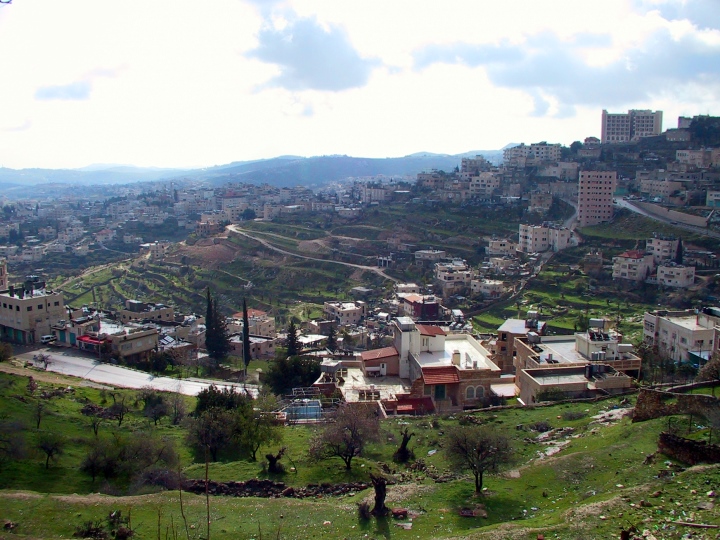
Some
of the terraced hills and fields of modern Bethlehem
To prevent confusion, most of the Bible writers identify which
Bethlehem they are speaking about, either by reference to other
nearby locations, or by referring to the southern Bethlehem as
"Bethlehem of Judea" or "Bethlehem Ephrath (alt.
Ephrathah)" End Note 1. Bethlehem
in Judea, the famous one, is located 5 miles (8 km) south of Jerusalem,
near the ancient main road to Hebron (and even Egypt, if one was
going further). This Bethlehem is also known in modern times as Beit
Lahm, Arabic for "house of meat" or "house of
flesh". Ancient Bethlehem was surrounded by fertile fields,
groves and vineyards, benefiting from a moderate Mediterranean
climate and being located at more than 2500 ft (760 meters) above sea
level (slightly higher than the highest point of Jerusalem!).
Average temperatures in the summer are in the low to mid 70s (20s C)
and high 50s (15 C) in the winter. Unlike the dessert region on which
it borders, Bethlehem's immediate surrounding had an ample rain fall,
annually running almost 20 inches (50 cm). Certainly it was a place
where food would have been plentiful - a "house of bread".
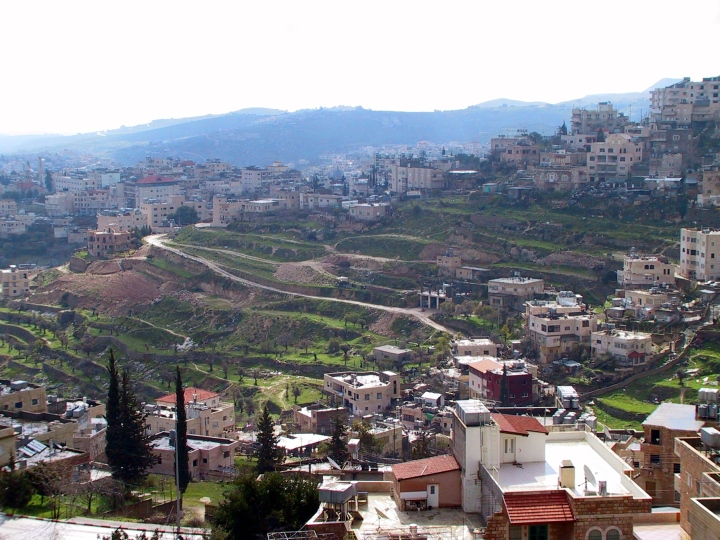
Closer
view of Bethlehem hills (see previous image for wider view)
It's easy to know why a New Testament writer would designate the
southern Bethlehem as being "of Judea", this was utilizing
not only a designation referring to the ancient tribal territories,
it also referred to the Roman region designated Judea. For many, the
stranger reference was Ephrath (alt. Ephrathah, in both the
"ph" pronounces as "f"). An early reference in
the Law established the usage of this identifier.
Genesis 35:16-20 Then they moved on from Bethel. While they were
still some distance from Ephrath, Rachel began to give birth and had
great difficulty. 17 And as she was having great difficulty in
childbirth, the midwife said to her, "Don't be afraid, for you
have another son." 18 As she breathed her last - for she was
dying - she named her son Ben-Oni. But his father named him Benjamin.
19 So Rachel died and was buried on the way to Ephrath (that is,
Bethlehem). 20 Over her tomb Jacob set up a pillar, and to this day
that pillar marks Rachel's tomb. (NIV)
The wording allows that Ephrath was either a
region, in which Bethlehem was located, or was an alternate name for
Bethlehem itself. Even a few hundred years after the time of Jesus,
the creator of the Madaba map designated
Ephrathah separately from Bethlehem, obviously believing that
Bethlehem was in the territory of the former.
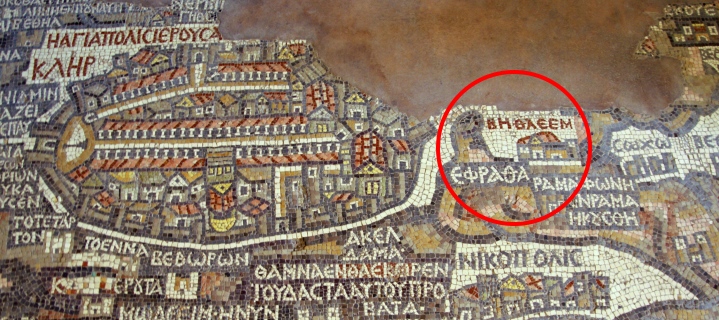
Bethlehem
and Ephrathah on the Madaba Map
Additional Bible passages also reference Ephrath, again in a manner
that it could be the same place as Bethlehem or having Bethlehem
within its territory.
Genesis 48:7 As I [Jacob or Israel] was returning from Paddan, to my
sorrow Rachel died in the land of Canaan while we were still on the
way, a little distance from Ephrath. So I buried her there beside the
road to Ephrath" (that is, Bethlehem). (NIV, square parenthesis
ours for clarification, round parenthesis in the Bible text)
Ruth 1:2 The man's name was Elimelech, his wife's name Naomi, and the
names of his two sons were Mahlon and Kilion. They were Ephrathites
from Bethlehem, Judah. And they went to Moab and lived there. (NIV)
Ruth 4:11 Then the elders and all those at the gate said, "We
are witnesses. May the Lord make the woman [Ruth] who is coming into
your [Boaz] home like Rachel and Leah, who together built up the
house of Israel. May you have standing in Ephrathah and be famous in
Bethlehem. (NIV, square parenthesis ours for clarification) [For a
few more infamous events regarding those of Bethlehem, during the
time of the judges, read Judges chapters 17 and 19].
1 Samuel 17:12 Now David was the son of an Ephrathite named Jesse,
who was from Bethlehem in Judah. Jesse had eight sons, and in Saul's
time he was old and well advanced in years. (NIV)
We are told specifically in the genealogies of 1 Chronicles, who the
father or founder of Bethlehem was:
1 Chronicles 2:51 Salma the father of Bethlehem... (NIV)
As seen in a previously considered passage (1 Samuel 17:12); David,
who would become God's anointed king over Israel, was the most famous
citizen of Bethlehem and he was called an Ephrathite. David was a
direct descendant of Ruth and Boaz, also residents of Bethlehem, as
confirmed by Mathew (1:5-6). When Samuel was commissioned by God to
appoint David as successor to Saul, he went to Bethlehem.
1 Samuel 16:1-5 The Lord said to Samuel, "How long will you
mourn for Saul, since I have rejected him as king over Israel? Fill
your horn with oil and be on your way; I am sending you to Jesse of
Bethlehem. I have chosen one of his sons to be king." 2 But
Samuel said, "How can I go? Saul will hear about it and kill
me." The Lord said, "Take a heifer with you and say, 'I
have come to sacrifice to the Lord.' 3 Invite Jesse to the sacrifice,
and I will show you what to do. You are to anoint for me the one I
indicate." 4 Samuel did what the Lord said. When he arrived at
Bethlehem, the elders of the town trembled when they met him. They
asked, "Do you come in peace?" 5 Samuel replied, "Yes,
in peace; I have come to sacrifice to the Lord. Consecrate yourselves
and come to the sacrifice with me." Then he consecrated Jesse
and his sons and invited them to the sacrifice. (NIV)
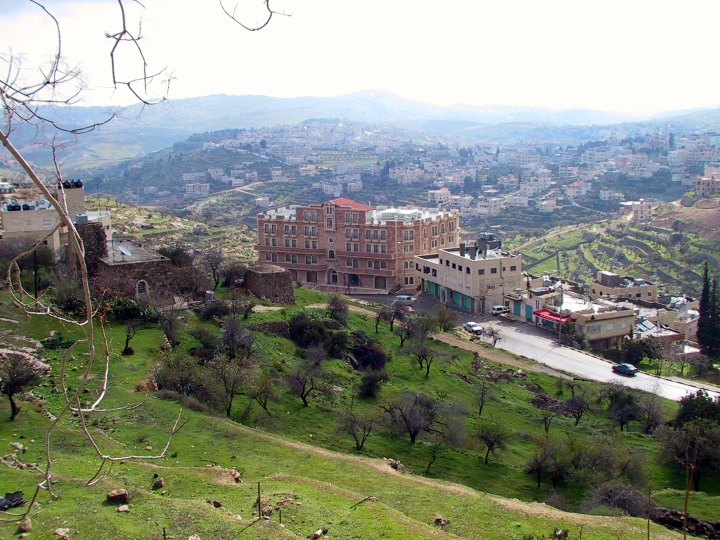
Looking
down from Bethlehem
It was at or near Bethlehem that David had tended sheep for his
father (1 Samuel 16:11). In David's time, certainly prior to his
formally becoming king, the Philistines who regularly plagued the
land occupied a location at Bethlehem.
2 Samuel 23:14-17 At that time David was in the stronghold, and the
Philistine garrison was at Bethlehem. 15 David longed for water and
said, "Oh, that someone would get me a drink of water from the
well near the gate of Bethlehem!" 16 So the three mighty men
broke through the Philistine lines, drew water from the well near the
gate of Bethlehem and carried it back to David. But he refused to
drink it; instead, he poured it out before the Lord. 17 "Far be
it from me, O Lord, to do this!" he said. "Is it not the
blood of men who went at the risk of their lives?" And David
would not drink it. (NIV) [Also 1 Chronicles 11:16-19]
David's grandson, who lost the northern part of the kingdom,
considered Bethlehem an important city and fortified it for defense.
2 Chronicles 11:5-11 Rehoboam lived in Jerusalem and built up towns
for defense in Judah: 6 Bethlehem, Etam, Tekoa, 7 Beth Zur, Soco,
Adullam, 8 Gath, Mareshah, Ziph, 9 Adoraim,
Lachish, Azekah, 10 Zorah, Aijalon and
Hebron. These were fortified cities in Judah and Benjamin. (NIV)
The Babylonian exile (circa 586 B.C.) and
subsequent return (circa 537 B.C.) saw
Bethlehem reduced to a small town quite sparsely populated.
Ezra 2:21 the men of Bethlehem, 123 (NIV)
Nehemiah 7:26 the men of Bethlehem and Netophah, 188 (NIV)
The minor prophet Micah, writing
before the exile (circa 740-690 B.C.),
already described Bethlehem Ephrathah as being small, showing that it
likely declined in stature during the divided kingdom.
Micah 5:2 "But you, Bethlehem Ephrathah, though you are small
among the clans of Judah, out of you will come for me one who will be
ruler over Israel, whose origins are from of old, from ancient
times." (NIV)
It is notable that the prophet Micah would single out a relatively
insignificant town and specifically assure it of future fame. Matthew
made it clear that the Messianic prophecy of Micah was well known by
the chief priests and teachers of the law:
Matthew 2:1-8 After Jesus was born in Bethlehem in Judea, during the
time of King Herod, Magi from the east came to Jerusalem 2 and asked,
"Where is the one who has been born king of the Jews? We saw his
star in the east and have come to worship him." 3 When King
Herod heard this he was disturbed, and all Jerusalem with him. 4 When
he had called together all the people's chief priests and teachers of
the law, he asked them where the Christ was to be born. 5 "In
Bethlehem in Judea," they replied, "for this is what the
prophet has written: 6 "'But you, Bethlehem, in the land of
Judah, are by no means least among the rulers of Judah; for out of
you will come a ruler who will be the shepherd of my people
Israel.'" 7 Then Herod called the Magi secretly and found out
from them the exact time the star had appeared. 8 He sent them to
Bethlehem and said, "Go and make a careful search for the child.
As soon as you find him, report to me, so that I too may go and
worship him." (NIV) |
|
Likewise,
the apostle John, in a later occurrence, indirectly noted that many
Israelites also were aware of Micah's specific prophecy that the
Messiah would come from Bethlehem.
John
7:41-43 Others said, "He is the Christ." Still others
asked, "How can the Christ come from Galilee? 42 Does not the
Scripture say that the Christ will come from David's family and from
Bethlehem, the town where David lived?" 43 Thus the people were
divided because of Jesus. (NIV)
Luke's
account of the birth of Jesus refers to Bethlehem as being in Judea
and then also calls it the "town of David".
Luke
2:1-16 In those days Caesar Augustus issued a decree that a census
should be taken of the entire Roman world. 2 (This was the first
census that took place while Quirinius was governor of Syria.) 3 And
everyone went to his own town to register. 4 So Joseph also went up
from the town of Nazareth in Galilee to Judea, to Bethlehem the town
of David, because he belonged to the house and line of David. 5 He
went there to register with Mary, who was pledged to be married to
him and was expecting a child. 6 While they were there, the time came
for the baby to be born, 7 and she gave birth to her firstborn, a
son. She wrapped him in cloths and placed him in a manger, because
there was no room for them in the inn. 8 And there were shepherds
living out in the fields nearby, keeping watch over their flocks at
night. 9 An angel of the Lord appeared to them, and the glory of the
Lord shone around them, and they were terrified. 10 But the angel
said to them, "Do not be afraid. I bring you good news of great
joy that will be for all the people. 11 Today in the town of David a
Savior has been born to you; he is Christ the Lord. 12 This will be a
sign to you: You will find a baby wrapped in cloths and lying in a
manger." 13 Suddenly a great company of the heavenly host
appeared with the angel, praising God and saying, 14 "Glory to
God in the highest, and on earth peace to men on whom his favor
rests." 15 When the angels had left them and gone into heaven,
the shepherds said to one another, "Let's go to Bethlehem and
see this thing that has happened, which the Lord has told us
about." 16 So they hurried off and found Mary and Joseph, and
the baby, who was lying in the manger. (NIV)
Skeptics,
attempting to disparage the Biblical account, have often mocked the
angel's statement that Jesus was born "in the town of
David". They claim that the shepherds would have understood this
to mean Jerusalem
(or a part of Jerusalem) and not Bethlehem. It is true that in 2nd
Samuel (i.e. 2 Samuel 5:7; 6:12), 1 Kings (i.e. 2:10; 3:1; 8:1;
9:24), 2 Kings (i.e. 15:38; 16:20), 1 & 2 Chronicles (i.e.
33:14), Nehemiah (i.e. 3:15), and Isaiah (i.e. 22:9), that Jerusalem
(or a part of it) is referred to as being the "City of
David". The Hebrew word translated "City" is a very
general word that can also mean "town" or
"encampment". So why would the shepherd look to Bethlehem
as being "the town of David" and not Jerusalem?
Because they, as with much of the populace, where aware of the
Messianic prophecies including Micah's specific one, that pointed
very clearly to Bethlehem. Figuratively speaking, all eyes were on
Bethlehem, this is where they expected something to happen - and it
too was legitimately called the "town (or city) of David",
being his ancestral hometown. The very fact that the Roman government
had so recently ordered everyone to their ancestral hometown for
taxation would have added extra emphasis; David's descendants weren't
going to Jerusalem to be taxed, they were going to the town of David, Bethlehem.
Perhaps
knowing that Ephrathah could mean a region around Bethlehem, or maybe
merely being an attempt to be thorough, King Herod had the infant
boys "in Bethlehem and its vicinity" killed, having been
outsmarted by the Magi.
Matthew
2:16-18 When Herod realized that he had been outwitted by the Magi,
he was furious, and he gave orders to kill all the boys in Bethlehem
and its vicinity who were two years old and under, in accordance with
the time he had learned from the Magi. 17 Then what was said through
the prophet Jeremiah was fulfilled: 18 "A voice is heard in
Ramah, weeping and great mourning, Rachel weeping for her children
and refusing to be comforted, because they are no more." End
Note 2 (NIV)
Early
church father Justin Martyr (lived circa 100-165 A.D.)
wrote both about Jesus' birth in Bethlehem (notably in a
cave-stable, common to the region) and of the Magi coming also to Bethlehem.
|
"Now
this king Herod, at the time when the Magi came to him from Arabia,
and said they knew from a star which appeared in the heavens that a
King had been born in your country, and that they had come to worship
Him, learned from the elders of your people that it was thus written
regarding Bethlehem in the prophet: 'And thou, Bethlehem, in the land
of Judah, art by no means least among the princes of Judah; for out
of thee shall go forth the leader who shall feed my people.'
Accordingly the Magi from Arabia came to Bethlehem and worshipped the
Child, and presented Him with gifts, gold and frankincense, and
myrrh; but returned not to Herod, being warned in a revelation after
worshipping the Child in Bethlehem.
And
Joseph, the spouse of Mary, who wished at first to put away his
betrothed Mary, supposing her to be pregnant by intercourse with a
man, i.e., from fornication, was commanded in a vision not to put
away his wife; and the angel who appeared to him told him that what
is in her womb is of the Holy Ghost. Then he was afraid, and did not
put her away; but on the occasion of the first census which was taken
in Judaea, under Cyrenius, he went up from Nazareth, where he lived,
to Bethlehem, to which he belonged, to be enrolled; for his family
was of the tribe of Judah, which then inhabited that region. Then
along with Mary he is ordered to proceed into Egypt, and remain there
with the Child until another revelation warn them to return into
Judaea. But when the Child was born in Bethlehem, since Joseph could
not find lodging in that village, he took up his quarters in a
certain cave near the village; and while they were there Mary brought
forth the Christ and placed Him in a manger... (Justin Martyr,
Dialogue with Trypho, Chapter 78)
A later
writer, Origen (lived 185-254 A.D.), wrote
also of Jesus' birth in Bethlehem and even claimed that the cave's
location was known and commemorated in his day.
Now the
Scripture speaks, respecting the place of the Saviour's birth-that
the Ruler was to come forth from Bethlehem-in the following manner:
"And thou Bethlehem, house of Ephrata, art not the least among
the thousands of Judah: for out of thee shall He come forth unto Me
who is to be Ruler in Israel; and His goings forth have been of old,
from everlasting." Now this prophecy could not suit any one of
those who, as Celsus' Jew says, were fanatics and mob-leaders, and
who gave out that they had come from heaven, unless it were clearly
shown that He had been born in Bethlehem, or, as another might say,
had come forth from Bethlehem to be the leader of the people. With
respect to the birth of Jesus in Bethlehem, if any one desires, after
the prophecy of Micah and after the history recorded in the Gospels
by the disciples of Jesus, to have additional evidence from other
sources, let him know that, in conformity with the narrative in the
Gospel regarding His birth, there is shown at Bethlehem the cave
where He was born, and the manger in the cave where He was wrapped in
swaddling-clothes. And this sight is greatly talked of in surrounding
places, even among the enemies of the faith, it being said that in
this cave was born that Jesus who is worshipped and reverenced by the
Christians. Moreover, I am of opinion that, before the advent of
Christ, the chief priests and scribes of the people, on account of
the distinctness and clearness of this prophecy, taught that in
Bethlehem the Christ was to be born. And this opinion had prevailed
also extensively among the Jews; for which reason it is related that
Herod, on inquiring at the chief priests and scribes of the people,
heard from them that the Christ was to be born in Bethlehem of Judea,
"whence David was." It is stated also in the Gospel
according to John, that the Jews declared that the Christ was to be
born in Bethlehem, "whence David was." But after our Lord's
coming, those who busied themselves with overthrowing the belief that
the place of His birth had been the subject of prophecy from the
beginning, withheld such teaching from the people... (Origen, Against
Celsus, Chapter 51)
Jerome
(lived 347-420 A.D.), who lived for
thirty-three years in Bethlehem (circa 387-420 A.D.),
wrote of Bethlehem in 404 A.D. In this
letter Jerome is remembering a visitor to the Bible Lands and
highlighting some of her experiences.
After this
she came to Bethlehem and entered into the cave where the Savior was
born. Here, when she looked upon the inn made sacred by the virgin
and the stall where the ox knew his owner and the ass his master's
crib, and where the words of the same prophet had been fulfilled
"Blessed is he that soweth beside the waters where the ox and
the ass trample the seed under their feet:" when she looked upon
these things I say, she protested in my hearing that she could behold
with the eyes of faith the infant Lord wrapped in swaddling clothes
and crying in the manger, the wise men worshipping Him, the star
shining overhead, the virgin mother, the attentive foster-father, the
shepherds coming by night to see "the word that was come to
pass" and thus even then to consecrate those opening phrases of
the evangelist John "In the beginning was the word" and
"the word was made flesh." She declared that she could see
the slaughtered innocents, the raging Herod, Joseph and Mary fleeing
into Egypt; and with a mixture of tears and joy she cried: 'Hail
Bethlehem, house of bread, wherein was born that Bread that came down
from heaven. Hail Ephratah, land of fruitfulness and of fertility,
whose fruit is the Lord Himself. Concerning thee has Micah prophesied
of old, "Thou Bethlehem Ephratah art not the least among the
thousands of Judah, for out of thee shall he come forth unto me that
is to be ruler in Israel; whose goings forth have been from of old,
from everlasting. (Jerome, Epistles 108 [Letter to Eustochium]:10)
In another
letter, written circa 395 A.D., Jerome noted
how the pagans had destroyed and appropriated sites related to
Christianity, which by his time had been restored for Christian
usages. Bethlehem had been specifically targeted around 135
A.D., under the reign of Hadrian (circa 117-138
A.D.), during which the already commemorated site of the
nativity was desecrated.
From the
time of Hadrian to the reign of Constantine-a period of about one
hundred and eighty years -the spot which had witnessed the
resurrection was occupied by a figure of Jupiter; while on the rock
where the cross had stood, a marble statue of Venus was set up by the
heathen and became an object of worship. The original persecutors,
indeed, supposed that by polluting our holy places they would deprive
us of our faith in the passion and in the resurrection. Even my own
Bethlehem, as it now is, that most venerable spot in the whole world
of which the psalmist sings: "the truth hath sprung out of the
earth," was overshadowed by a grove of Tammuz, that is of
Adonis; and in the very cave where the infant Christ had uttered His
earliest cry lamentation was made for the paramour of Venus. (Jerome,
Epistles 58 [Letter to Paulinus]:3)
While
residing in Bethlehem, Pope Damasus I instructed Jerome to begin a
revision of the Latin New Testament plus a comparison of the Greek
version of the Old Testament with the Hebrew, all which subsequently
led to the formation of the Latin Vulgate. The chamber (cell) where
Jerome did his work is maintained as a chapel in Bethlehem's Church
of the Nativity (or, more properly, under the connected Church of St.
Catherine). Jerome's chamber predates the extension (i.e. the Church
of St.Catherine) by many centuries.
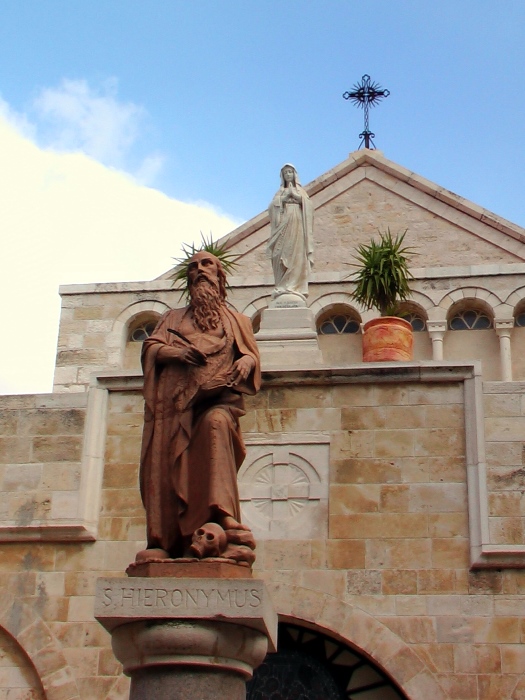
The
Church of St. Catherine - connected to the Church of the Nativity
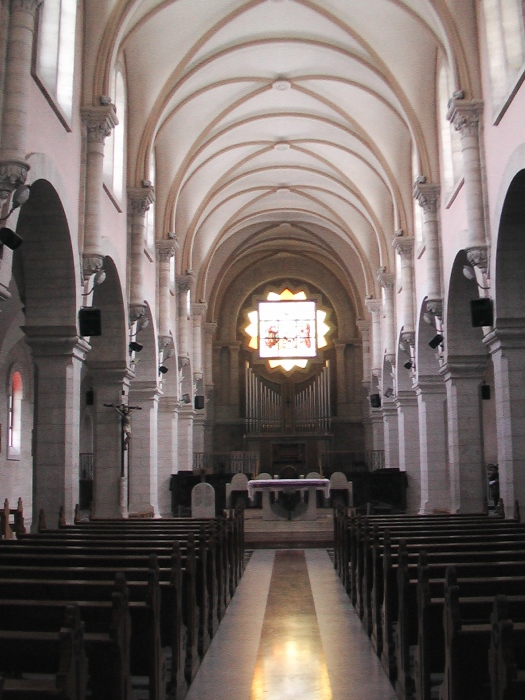
Inside
the Church of St. Catherine (Roman Catholic) - connected to the
Church of the Nativity
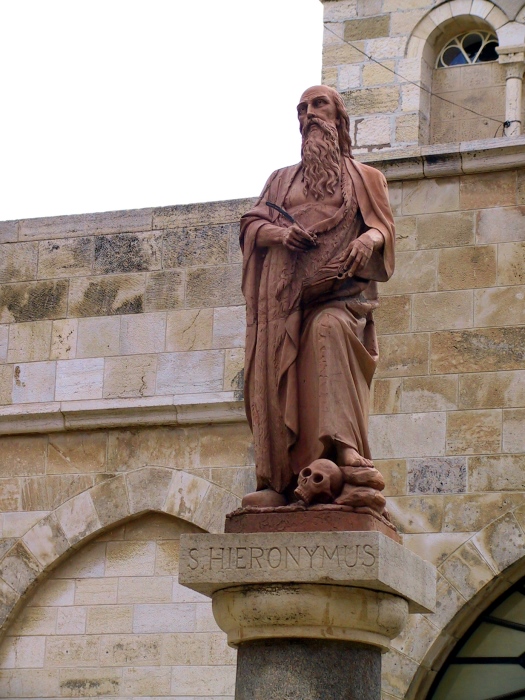
Statue
of Jerome outside the Church of St. Catherine - connected to the
Church of the Nativity
Jerome's
Latin name is: Eusebius Sophronius Hieronymus
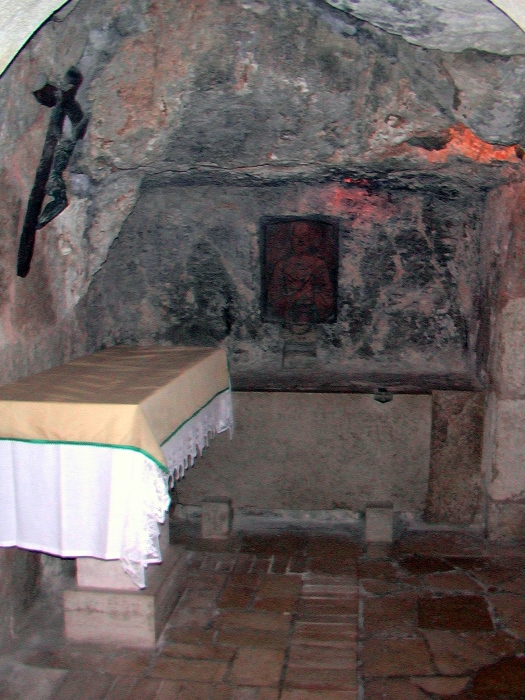
Jerome's
chamber (cell)

Better
view of the inscription in Jerome's chamber (cell) |
|
The Church
of the Nativity, which marks the birthplace of Jesus, is actually one
of the best authenticated traditional sites in Israel. While no
direct archaeology supports the location as being Jesus' birthplace
(i.e. an inscription "Mary and Joseph were here."), there
is an almost unbroken history of tradition regarding the site. The
citations of early church fathers, as given previously, show that
they were well aware of the site from an early period, at least from
the second century. As such, apart from actually being an historical
known location, the early timeframe makes it rare that it would be
merely a traditional site, something that became more common in later
centuries following the legal toleration and adoption of Christianity
by Constantine I. Helena, the mother of Emperor Constantine, had a
church (basilica) built on the over the site in 327-333
A.D. That church was burnt in the Samaritan Revolt of 529
A.D. and subsequently repaired, replaced, and expanded, by the
present structure during the reign of Emperor Justinian I in 565
A.D. This history gives the church claim to be the oldest
functioning famous church in the world.
When the
Persians invaded the area in 614 A.D. they
unexpectedly spared the structure. It is said that they spared the
church because their leader, Shahrbaraz, recognized the clothing on
the painting of the Three Magi inside the church as being Persian.
Later, the Arabs (636 A.D.) and the Crusaders (1099
A.D.) all left the church unharmed. The crusaders actually made
repairs and expansions to the building. Likely directly in response
to historical problems, the three large gates of the basilica were
modified into a small entrance as a means of preventing riders on
horses from entering the building. This 4 foot (1.2 meter) door is
now called "the Door of Humility".
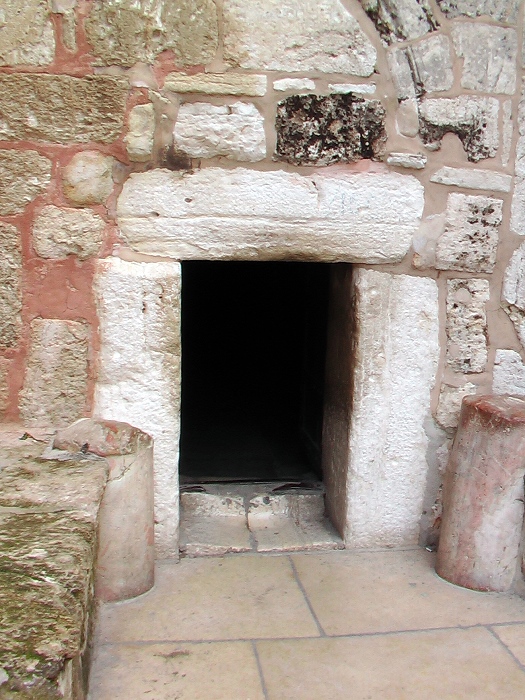
The
Door of Humilty at the Church of the Nativity
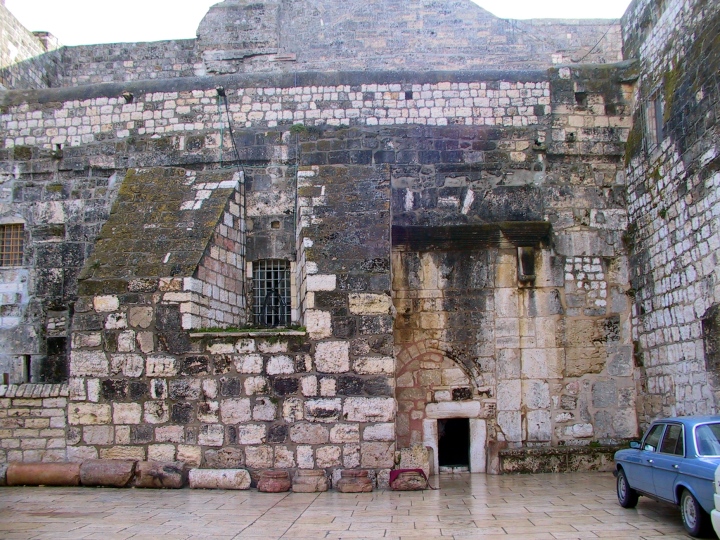
The
doorway with traces of the original entrance.
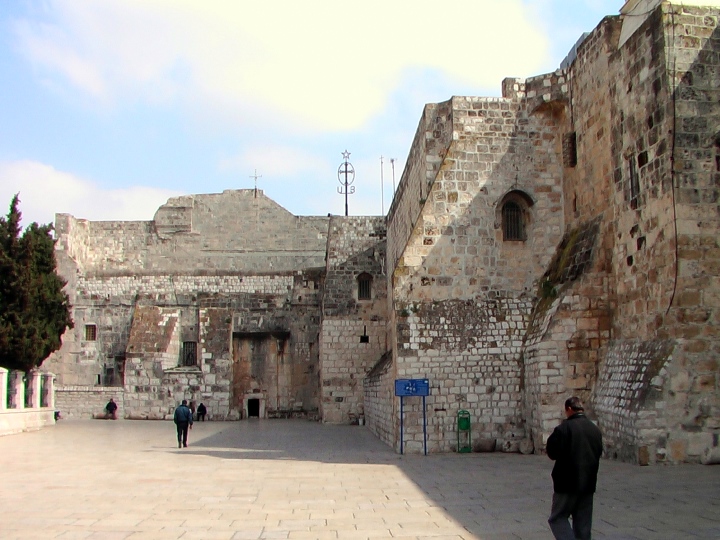
Moving
further away from the Church of the Nativity
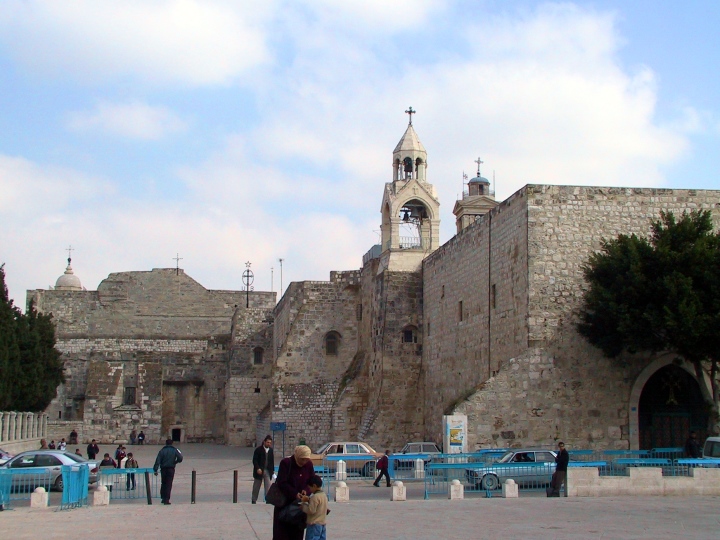
Moving
still further away from the Church of the Nativity (into Manger Square)

Church
of the Nativity from Manger Square
|
|

Door
to the grotto of the Church of the Nativity
Grotto
is down stairs from each side of the choir, under the chancel,
occupying the center of the transept
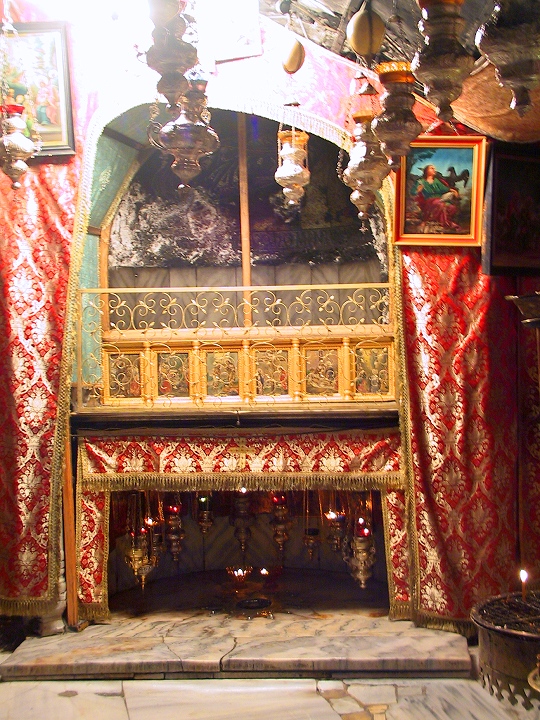
At
the east end of the crypt is a silver star supposedly marking the
exact spot where Jesus was born
The
star is inscribed with "Hic de Virgine Maria Jesus Christus
natus est",
which
translates to "Here of the Virgin Mary Jesus Christ was born")
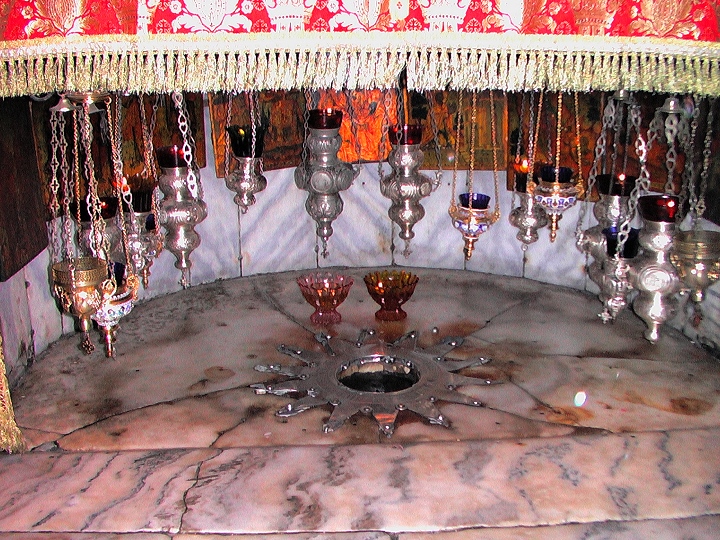
Closer
view of the silver star supposedly marking the exact spot where
Jesus was born
Of
the fifteen lamps around the star that are continuously kept buring,
day and night,
six
belong belong to the Greek Orthodox, five to the Armenian Church and
four to the Roman Catholic Church.
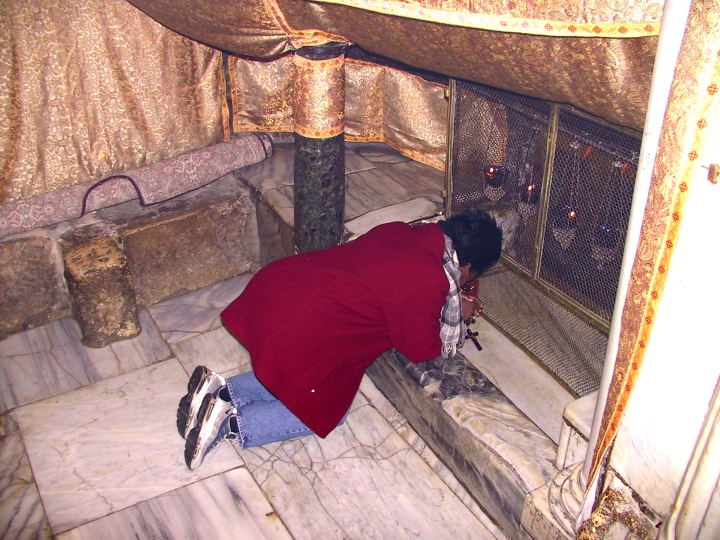
Near
the front of the grotto the manger is marked (of course, now covered
in ornate stone!)

Another
view of the manger area
The
original Roman style mosaic floor of the Basilica of the Nativity was
covered centuries ago, but a trap door exists in the modern floor
revealing a portion of the original (see photo below).

Ancient
mosaic floor of the Church
The
modern, and even more expanded church, is administered jointly by the
Roman Catholic Church, the Greek Orthodox Church and the Armenian
Church. The towers and wall which depict Bethlehem on the Madaba
Map were destroyed and the surrounding moat was filled in 1489
A.D. |
|

The
ever-present Mosque that will always be close to a church in a
Muslim area
(at
Manager Square, view from by the doorway to the Church of the Nativity)
The
Christian population of Bethlehem has been declining for decades |
|
End Notes
1. One of the Judges was said to be from
Bethlehem. Unfortunately, there is nothing directly in the text to
identify which Bethlehem. Some scholars lean towards the reference
being about the better known Judean Bethlehem mostly because there is
no other identifier. Others favor the northern Bethlehem in Zebulun
because his successor was a Zebulunite.
Judges 12:8-12 After him, Ibzan of Bethlehem led Israel. 9 He had
thirty sons and thirty daughters. He gave his daughters away in
marriage to those outside his clan, and for his sons he brought in
thirty young women as wives from outside his clan. Ibzan led Israel
seven years. 10 Then Ibzan died, and was buried in Bethlehem. 11
After him, Elon the Zebulunite led Israel ten years. 12 Then Elon
died, and was buried in Aijalon in the land of Zebulun. (NIV)
2. To understand Matthew's use of Jeremiah's
statement "A voice is heard in Ramah, weeping and great
mourning, Rachel weeping for her children and refusing to be
comforted, because they are no more." It must be understood to
be a figurative parallel to earlier events.
To understand this quotation it must be borne in mind that in Old
Testament times Ramah (modern er-Ram) was located on the border
between the two kingdoms, Israel and Judah (I Kings 15:17; II Chron.
16:1). It was situated five miles north of Jerusalem. It was the
place where foreign conquerors ordered the defeated multitude to be
assembled for deportation to far away places. Because of its location
it was able to represent both kingdoms. This last statement holds
also for Rachel, Jacob's most cherished wife. She, too, having given
birth to Joseph, the father of Ephraim and Manasseh, could represent
Israel, the kingdom of the ten tribes (sometimes simply called
"Ephraim"); and having borne Benjamin, could symbolize
Judah, the kingdom of the two tribes (Judah and Benjamin). ... The
parallel drawn by Matthew is very clear. Because of the slaughter of
Bethlehem's infants he pictures Rachel as weeping once more, and for
essentially the same reason. These children, too, are no more. This
time the worldly power that destroyed them was not Assyria or
Babylonia but Edom, as represented by cruel King Herod. Bethlehem's
infants of two years and under have been killed. The child who was
the main object of Herod's wrath has been driven into exile. He is
fleeing to Egypt. But also in the present case there is a full
measure of consolation, if the one bereft would only take it to
heart. That comfort centers in the same "Branch of
Righteousness" of whom Jeremiah spoke. Presently he will return
from Egypt in order to save all those who place their trust in him.
(New Testament Commentary by William Hendriksen and Simon J.
Kistemaker, Copyrights © 1953-2001 by Baker Books, William
Hendriksen, and Simon J. Kistemaker) |
|
(c)
2009, photos 2003 and 2005
All
BibleIsTrue.com articles may be reprinted for non-profit purposes as long
as
the source is cited: www.BibleIsTrue.com (Lion Tracks Ministries)
A
courtesy email is appreciated. |